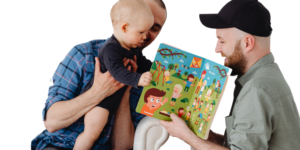Supporting Your Young Child’s Skill Development
July 15, 2022

If you are a parent of a child showing “red flags” of autism, you likely feel that precious time is being lost during the long wait time for an autism diagnostic evaluation. While it is true that early identification and treatment are essential, you are the most important teacher in your young child’s life. You may be frustrated or feel at a loss when trying to communicate and play with your child, as the signs and symptoms of autism can make these things more difficult.
There are, however, things you can do to enhance your child’s learning during this time. Below we explore the ways parents can strengthen key skills with their young child while they wait for diagnostic clarity and treatment to begin.
Keep your child’s age and developmental stage in mind.
The skills outlined below are typically delayed or missing in young children showing signs of autism and are likely a good place to start. It is important, however, to consider your child’s age and developmental level when deciding on which skills to focus.
The CDC Milestone Tracker can help you identify goals that are developmentally appropriate. It is important to note that individuals with autism may have some skills at, below, and/or above their age level. For example, they may be on target with vocabulary but not show developmentally appropriate play skills.
Also, the type of teaching strategies you use should be personalized that take account of their strengths, skill deficits, and preferences. Individuals with autism often require specific teaching strategies and repeated practice to improve.
Skills to Build
 Joint AttentionJoint attention is the shared focus by two people on the same object.Research shows that many individuals with autism struggle with joint attention. For example, your child may seem more isolated and “object focused” rather than looking at you to share experiences and enjoyment. While some hold the opinion that individuals with autism should not be required to make eye contact, here are some ways to promote this shared engagement: Read more
|
 ImitationImitation is the ability to copy another person’s words and actions.It serves as a foundation for learning from you, peers, and teachers. All of us learn via imitation (e.g., watching cooking shows or watching YouTube videos on how to swing a baseball bat), and research shows that strong imitation skills correspond to better language and social outcomes . Typically, children learn to imitate very early in life and continue to learn through imitation as they grow older in many different activities and contexts. Unfortunately, one of the most salient deficits in autism is a lack of imitation skills. You can improve imitation skills by consistently providing verbal, physical and play action models during typical daily and play routines. Read more
|
 CommunicationCommunication is how we let others know what we want and need as well as understand what others are trying to tell us.Obviously, this skill is crucial to all aspects of your life. Your child may have difficulty using words to communicate, have limited social skills, or difficulty following simple directions. Unlike typically developing children, children with autism often do not learn to communicate effectively through natural opportunities and need a great deal of motivation and practice. Read more
|
 PlayPlay is important for all young children; it is the primary way they learn.It’s a time to promote your child’s attention outward using an enriching environment while practicing communication and social skills. Many of the skills listed above are best taught in a fun way during play. Unfortunately, parents of children with autism or suspected autism often express that playtime is challenging because their child has a short attention span, difficulty complying with basic directions, a limited range of interests, or perseverates (e.g., lining up toys, having an intense desire for sameness). Read more
|
 BehaviorDuring early childhood, many children exhibit tantrum behavior and resort to using problematic behaviors to express themselves or get something they want.Some challenging behavior - even mild aggression and self-injury - is a typical part of early childhood development; the terms “terrible twos” and “threenager” exist for a reason! Children who are unable to use words to communicate rely heavily on their actions to “tell” us what they are thinking and feeling. However, your child’s behaviors may be occurring frequently or intensely enough that it is interfering with their ability to interact with others in positive ways. In addition, these tantrums may be occurring over small things, and you may find yourself avoiding certain activities or taking your child to certain places. Some children will decrease or stop these behaviors as they get older and gain more skills, but what is manageable when your child is younger may not be as they get older and bigger. If you find yourself “walking on eggshells” to avoid a problem, more specific support for these behaviors may be necessary. It may help to consider the following when addressing problem behavior in your child: Read more
|
 Activities of Daily LivingActivities of daily living (ADLs) are basic skills your child needs to navigate their daily lives, such as getting dressed, feeding themselves, toileting, and washing hands.By introducing self-help skills early, your child will learn the tools that lead to more independence at home, school, and in the community. It is normal for young children to require help with these skills (e.g., very few 3-year-olds are fully independent with toileting), but due to difficulties with imitation and communication, many children with autism need more time and individualized strategies to develop these skills. Read more
|
Looking for ways to prepare for the autism evaluation appointment and service options? Read our article on Steps to Take While You Wait for a Diagnostic Evaluation.
We’re Here to Support You
Most parents of young children are busy and tired; having concerns about your child’s development only adds to this stress. Many of us think parenting should come naturally; researching and learning additional ways to interact with your child can be overwhelming and upsetting. It may help to join a parent support group which may offer resources and support to help. In addition, Autism New Jersey’s 800.4.AUTISM Helpline is always available for support and reliable resources.
